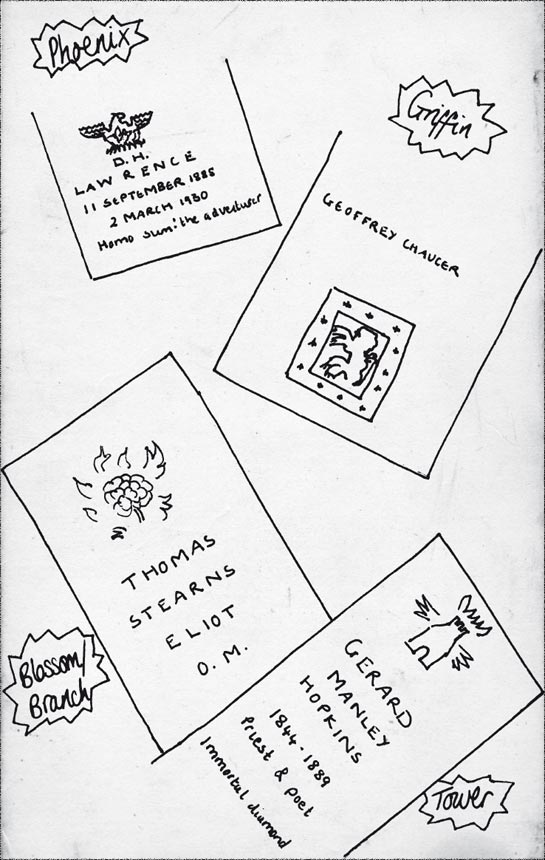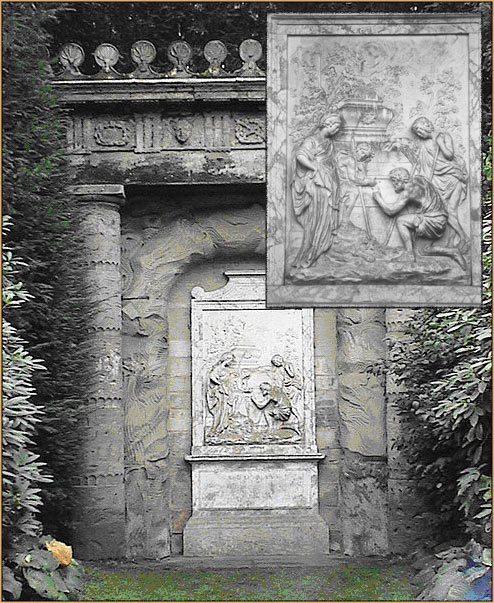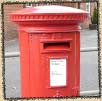Secrets to Break: Book Four

‘Why exactly have we come to London?’ asked Brodie, tightening her Pembroke blazer around her as the wind whipped litter in spirals along the pavement. …
…
‘Death,’ said Hunter.
‘Excuse me?’
‘Death. It’s Sicknote’s idea. Said checking out Tennyson’s grave to see if we could find some extra clues was a really great idea.’
Sicknote hurried over to join them as they pushed their way through the hordes of tourists bustling outside Westminster Abbey. ‘Bacon’s death-bed letter helped us, right? And think about how using the memorial stone at Piercefield and St Arvan’s memorial tree made everything clearer. Graves can help that way. The most important thing you need to know about someone may be written on their grave. It’s worth a look, don’t you think?’
(Extract from Secret Breakers Book Four ‘Tower of the Winds.’) Show the full extract
At this stage in the series, Team Veritas have already had to tackle codes hidden in all sorts of ways. I had great fun in Book Four, though, exploring physical codes that were hidden in buildings and monuments.
This doesn’t mean that writers of poems and stories didn’t leave behind important clues for the characters to put together in ‘Tower of the Winds’. Far from it! A huge collection of clues came from a very special place where a whole host of writers just happen to be together. That place is Poet’s Corner in Westminster Abbey, London, England.
“If you haven’t read Book Three yet you might want to come back to this page later as there are bound to be spoilers”
Memorial stones with monumental messages!
Writing on headstones and graves is a clever way to leave behind vital information. I’ve always been fascinated by what gets recorded on a gravestone. (This idea becomes even more important in the fifth installment of the Secret Breakers adventure so try to remember that!) In Book Four, all sorts of connections are put together by linking what is found on the grave stones inside the Abbey in London.
When writing the series, I had certain connections and links mapped out from the very beginning and in the writing of the six books I was trying to string the links together like putting beads on a necklace. I visited Westminster Abbey because I wanted to check some details about some of the ‘beads’ I was adding and I stumbled across an amazing ‘pearl’ to add to my string!
It was incredibly exciting for me to discover that on the floor-stones of the Abbey in Poet’s Corner there is an image of a phoenix, a griffin and blossom. And the fourth image close by really does appear to be a Tower of the Winds. Check out the video link for a tiny snatch of the detail inside the Abbey!
If you want to see the floor-stones at Westminster Abbey then follow this link to the Abbey’s own site.
Brodie’s sketch here though, shows you the information on the important stones.

Codes connected to Shakespeare
Careful readers of ‘The Knights of Neustria’ will have been waiting for extra information to come from Shakespeare and it’s the two memorials to him in ‘Tower of the Winds’ that lead the team to the work of Peter Scheemakers and eventually to Shugborough Hall. I was so excited to find that the Shakespeare monument in Westminster Abbey and the ‘near copy’ in Leicester Square, London, had slightly different information to share. Secret Breaking is all about the little details and that ‘signpost’ leading the team to think about islands, after making a connection to Shakespeare’s play ‘The Tempest’, was vital. Hopefully, you’re beginning to see that the idea of far-away islands is really important to the team!
You should also remember the distance markers the team noticed on the ground at Leicester Square. Remember, it’s all about the details, and this detail, which we are relying on Hunter to remember, might be important later on in the series!

Shugborough’s Secrets
One of the most ‘important’ secrets broken in ‘Tower of the Winds’ is discovered at Shugborough Hall, a stately home in the middle of the English country side. If you want to check out Shugborough Hall then take a look at the official website here.
It’s at Shugborough that Team Veritas come across lots of unusual buildings. There’s the Triumphal Arch of course, and the Tower of the Winds, but the most striking structure is The Shepherd’s Monument.


Mrs Hummel led the way to the north side of the grounds. …
…
The sky was darkening to an inky blue again and the air sparked with drizzle. The team didn’t talk as they moved.
Finally, Mrs Hummel led them to a large stone archway, flanked by two thick stone pillars. Stretched across the top of the pillars was an ornate plinth. In the centre of the archway was a sculpted picture. It showed four stooped people, who looked a bit like shepherds, looking down.
Brodie stepped forward for a closer look.
The four figures were looking at a tomb covered with flowers and branches. On top of the tomb was a small pyramid. Across the tomb, letters were carved, and two of the sculpted people were pointing at these letters although Brodie couldn’t make out the words they formed.
Everyone was quiet. Brodie felt like she did in Westminster Abbey: cold and a little afraid. But this time there wasn’t the excitement of being where great writers and poets had come for their final rest. This tomb was anonymous. It had no name she could make sense of.
(Extract from Secret Breakers Book Four ‘Tower of the Winds.’)Show the full extract
Poussin painting
Any book or website listing famous un-cracked codes is bound to talk about this monument. Again, I knew from before I even wrote a word of Book One in the series, that I would be including this monument in the Secret Breaker’s puzzle. I had read that real workers from Station X had tried to make sense of this code, so I knew it had to be included. Check out this news report which explains this.
The monument was commissioned by the Anson family and put together by the Flemish sculptor Peter Scheemakers. The image in the centre of the monument is a copy of the Poussin painting.

It shows a woman and three shepherds, two of whom are pointing to a tomb. On the tomb is carved the Latin text Et in Arcadia ego ("I am also in Arcadia" or "I am, even in Arcadia"). Secret Breakers would do well to remember this link to Arcadia which is the name often used for a perfect place. This is going to become more and more important as Team Veritas continue their adventures!
There are a few changes from the original Poussin painting. The picture is reversed, or a mirror image, for a start and also there’s a pyramid tomb added to the stone carving. You can see why a trip to Fuller’s Follies was so important to the team after seeing that pyramid tomb!
The shepherds seem to be pointing to certain letters on the carving so Team Veritas think these letters are key to providing answers.
Below the carving on the monument, a craftsman has added the mysterious eight letters, contained within the letters 'D M'. Many attempts have been made to make sense of this cryptic message. Team Veritas use the fact that the picture is reflected to help them reflect the code and come up with a message!


You might have your own ideas for cracking this code though! There are lots of other theories about what it might mean!
 If you do manage to make sense of the cipher then do let me know. Send your code breaks to H.L. Dennis c/o Hodder Children’s Books, 338 Euston Road, London NW1 3BH. We’ll try and send you a ‘Secret Breakers’ bookmark (while stocks last) to anyone who has a go!
If you do manage to make sense of the cipher then do let me know. Send your code breaks to H.L. Dennis c/o Hodder Children’s Books, 338 Euston Road, London NW1 3BH. We’ll try and send you a ‘Secret Breakers’ bookmark (while stocks last) to anyone who has a go!
The might of the marvellous mirror
Looking in a mirror can often help you find answers… like to the question ‘what have I got all over my eyebrow?’ or even ‘what does the back of my head look like?’! (Think about that one…you might have to use two mirrors!)
So writing a message that can only be read using a mirror is an excellent form of steganography. Remember, steganography is when writing looks different and is hiding a message. The Baconian Bilateral Cipher is another form of Steganography and you can find out more about that on the Secrets to Break: Book Three page.
If you look carefully through your copy of ‘Tower of the Winds’ you might find a secret that can only be broken if you have a mirror to hand.

Nowadays code writers who use a computer can easily reverse writing. Maybe you can have a go at doing this yourself! The instructions are here.
So…did you manage it? Can you be a mirror writer like the famous Leonardo DaVinci who wrote all his notes in mirror writing so no one could steal his ideas!

Challenge Time!
Now you’ve learnt all about this special form of steganography called Mirror Writing and maybe even had a go on your computer, what about trying the old fashioned way with a piece of paper and a pen? You’ll be amazed to learn that there are some people who can actually ‘mirror write’ just as easily as they can write forwards. Maybe you are one of these incredible people and you won’t really know until you have a go. (Don’t be disappointed if you can’t by the way. I’m useless at it!)

If you do manage to write a message backwards then send it on for me at to see.
Post your mirror writing message, along with a translation, so I know you understand what you have written, to H.L. Dennis c/o Hodder Children’s Books, 338 Euston Road, London NW1 3BH. If you prove yourself to be a marvelous mirror writer then we’ll try and send you a ‘Secret Breakers’ bookmark (while stocks last)!
To encourage you, then take a look at this incredible video of a girl who can mirror write. Keep watching right until the end and see how using light reveals what she has written. Doesn’t that fit in with all that Secret Breakers have learnt about secrets during their adventures? Light is knowledge after all!
So happy mirror writing everyone and Good Luck with tackling the code of the Shepherd’s Monument!
When you’ve learnt all you can about the codes covered in Book Four, click the link below to take you to explore the next secret in the series!
 Helen's Other Books
Helen's Other Books Find Me on Instagram
Find Me on Instagram